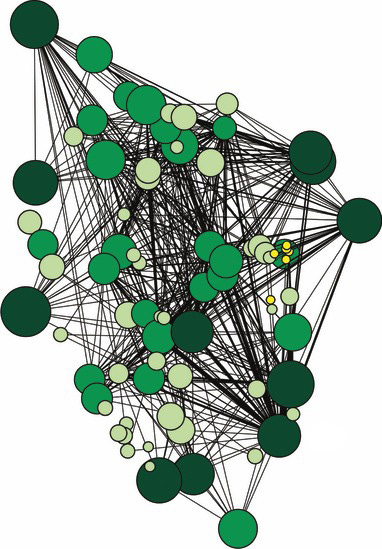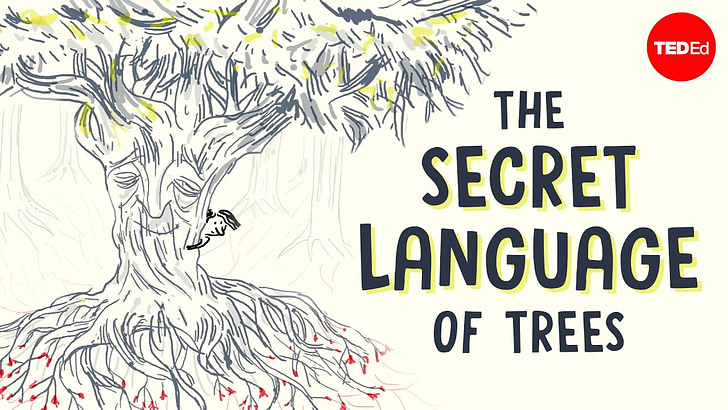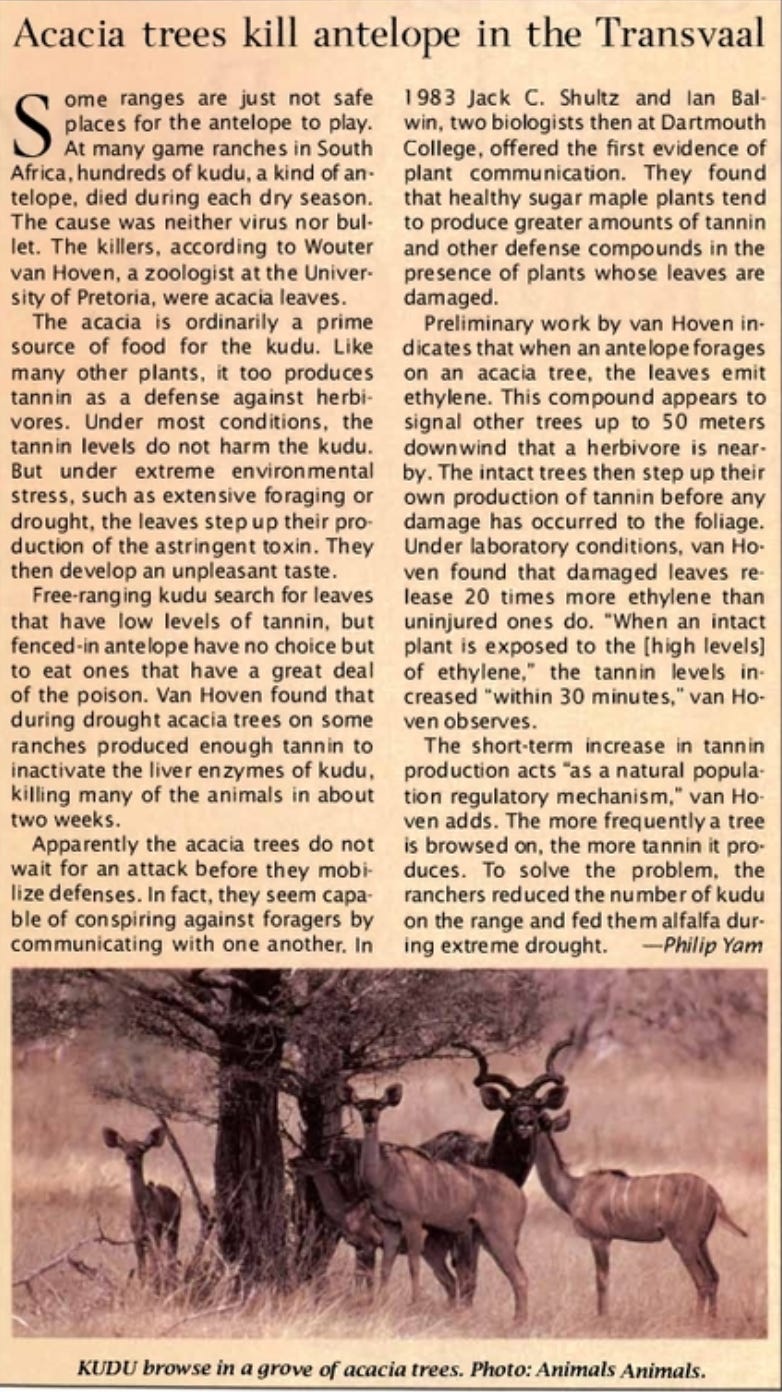In the Eifel mountain forests of German sits an enormous tree stump. A beech tree, four or five hundred years old once stood tall and proud. However, despite its dead, long gone appearance, it is still alive, producing chlorophyll. But how?
In 2009, James Cameron’s film Avatar introduced the idea of a soul tree, the hub of an enormous communicative network which could be tapped into by the Na’vi, the inhabitants of a fictional planet, Pandora.
The story drew on the emergence of a body of scientific research into the life of forests, not as a collection of individual entities, but as a vast communicative network.
Trees communicate through their root structures and through airborne emissions. Trees communicate through chemical compounds, hormones, and electrical pulses. Trees communicate with allies to help in times of need. Trees appear to smell, taste, feel, and hear. Trees appear reluctant to let go of their dead.
Back in 1997, a forester turned scientist found that one pine seedling root could transport carbon to a second pine seedling root. Excited by the idea that trees talk to each other, she set out to replicate her findings in the heart of the forest. She was laughed at and struggled to get funding.
Suzanne Simard and her team embarked on an ill-conceived journey into the forest with 80 saplings of paper birch, Douglas fir and western red cedar, and supermarket grade and borrowed equipment. On the basis of what she knew so far, she hypothesised the birch and fir would talk to each other, but the cedars would remain separate in their own other world.
Their first day didn’t go so well. A female grizzly bear with a cub chased them off. The second day went according to plan, they planted the saplings, covered them with plastic bags in a variety of conditions. Birch bags were injected with a radioactive carbon gas and the fir with a different carbon gas, to see if there would be two way communication between them. After another grizzly bear send off, Suzanne waited an hour in the confines of her truck before venturing back out to see if any carbon transfer had occurred. It had. Not only was the birch radioactive, but so was the fir. She checked other trees. The fir and birch, as expected, were having a lovely two way conversation, but cedars were excluded from the party. (Later, it turned out, they prefer the company of maples.)
There were seasonal variations in the exchange. In summer, the birch optimised sharing with firs which were kept under cover of shade. In winter, when the birch had no leaves, the fir raised the level of carbon it passed to the birch in a mutually beneficial, year round relationship.
Here’s the easy science behind that exchange (less than 5 mins):
A symbiotic relationship with fungi facilitates the conversation. Fungal roots, or mycorrhizae, connect with tree roots to receive a form of nutrition. The tree gives about 30% of its nutritional output to the mycorrhizae which in turn perform a few jobs for the tree, like passing on messages and resources to other trees such as carbon, nitrogen, phosphorus and water, defensive signals, hormones, and other chemical information.
Suzanne and her team then began to map the extent of the network within a specific forest area and discovered that some trees are hubs for forest activity. She affectionately calls them mother trees. These connect with hundreds of other trees, including seedlings which receive extra carbon, giving them a four times better chance of survival than if you planted it in the middle of your lawn. Mother trees also have a preference for their own kin. Through their interactions the hubs improve the resilience of the entire forest. Their loss could mean entire system collapse, just like the soul tree in the Avatar film.

It’s not difficult to see why this phenomenon has been coined the Wood-Wide Web. Researcher Florianne Koechlin suggests it isn’t only trees and fungi that are interconnected below our feet, but other plants benefit from and contribute to the mycorrhizal net.
When we look up into the canopy of trees and imagine they are talking, they are probably communicating through the air, using pheromones and other scent signals. A famous example of this, from one of the first studies to discover tree communication, is a form of communication employed by the thorn acacia. At first glance the tree is no different to other plants which have evolved external defences against herbivore decimation. Its thorns are very long, deterring even the most intrepid of herbivores and its tap root runs deep enough to survive drought. It also has a symbiotic relationship with a specific species of ant. It provides the nutritional diet the ants can’t find elsewhere in return for alerting the colony to attack and sting any approaching animal.
However, giraffes have tongues which means they can overcome the thorn acacia defences. To deter this particular threat, the tree emits a distress signal in the form of ethylene gas when a giraffe begins chewing its leaves. Neighbouring acacias when they detect the gas start pumping tannins into their leaves which can sicken and even kill herbivores as large as giraffes. The range of communication extends to around 45 metres, putting off herbivores from decimating the tree population. (Giraffes have learned to eat facing the wind, and on a still day move 100m before eating the next plant.)
Since this first study, there is an expanding scientific field of tree and plant communication.
Elms and pines have a lot in common with your garden tomatoes. Have you ever wondered why caterpillars manage to find their way through an entire brassica crop, yet tomatoes are barely touched?
Florianne Koechlin tells us how. When under threat of a pest attack, e.g. caterpillars, or spider mites, tomatoes release methyl jasmonate into the air, a scent regularly used in the perfume industry. Unlike our own response to the aroma, nearby tomatoes interpret the smell as a threat (avoid Chanel no. 5 if tending tomatoes). The plants are even able to discern which pest is attacking them. They release a different cocktail of fragrances dependent on whether it wants to attract spider mite predators or parasitic wasps to deal with caterpillars. How on earth are they able to make that distinction and respond accordingly? It is as if it can taste the threat. Differences in the saliva of the attacking species drives the appropriate scent concoction to attract the right kind of pest control to its leaves.
If you notice great tits feasting near apple trees, it’s not the fruit they have gathered for. Like tomatoes, apple trees when sensing caterpillar invasion, emit an aroma which attracts great tits to deal with the pest.
Similarly, some trees know the ‘taste’ of deer saliva. When a branch is bitten into, the tree brings chemicals to make the leaves taste bad, but if a human prunes a branch, the tree knows the difference and brings in substances to heal the wound. And riverside trees love the delicacy of salmon nitrogen created by fish-eating bears and pass it down the network to their buddies. Their response is as if they can smell the carcass of fish.
And if that wasn’t amazing enough, it seems that plants have ears too. In Australia, Monica Gagliano found that garden pea roots grow toward the sound of running water. That in itself doesn’t mean that they are hearing the water, except that they were able to tell the difference between a recording of the sound of running water from the actual sound of running water. And information about where water can be found is passed via the wood-wide web.
Florianne views the sum of the data not only as a form of communication, but also as a kind of vocabulary of a language. By 2016 over 1000 different defensive perfume compounds have been discovered, five to ten of which are common to all plants. Additionally, they can perceive about twenty more environmental cues than humans can, including electromagnetic waves like birds do.
Like humans they can respond to smell, taste, touch, sight, and sound. Like birds they sense electromagnetic waves, and under the ground there is a communication too.
Florianne Koechlin (2016)
I haven’t found evidence for the sight responses, but smell, taste, touch and sound is pretty awe provoking, especially when receptors for these inputs are somewhat lacking.
While Suzanne emphasises the cooperative nature of forest life, Florianne states that not all plant communication is about helpful, give and take or defensive warning. Marigolds for instance secrete a substance through their roots which discourages other plants from growing nearby. Plants aren’t always altruistic.
But they are capable of learning. They adapt their behaviour in light of past experience, like they have a memory of the event. After a specific caterpillar attack, a plant will respond more quickly and vigorously a second time than it did before. A birch can remember for as long as up to four years. Wait a minute, was it a birch or a beech in that study?
To sum up, plants are by no means living automatons, always reacting in the same way and following the genetic programme. While this notion is still held within the scientific community, the contrary is true. Plants communicate both above and below ground, they engage in lively relationships with their peers and their environment. They harrass, they build alliances, they remember, they learn, and some scientists even think they are intelligent. And philosophically speaking we could say a plant is not an object, an it, but rather a sensitive living being, a she.
Florianne Koechlin (2016)
The implications of the findings are vast, raising philosophical and ethical questions in addition to practical.
We must at least talk about the rights of trees. We must manage our forests sustainably and respectfully, and allow some trees to grow old with dignity, and to die a natural death.
Peter Wohlleben (2018) in interview with Richard Grant for the Smithsonian Magazine.
We must … allow some trees to grow old with dignity, and to die a natural death? Let’s return to the large living beech stump in Germany. How is it able to still produce chlorophyll? It is alive because the community it once served, and was served by, is reluctant to let it go. The network of which it was a part is keeping it alive, not unlike a life support machine. I can only wonder at how that must make it feel, what they feel when trying so hard to save it.
Trees have feelings?
It is a long way from saying that trees communicate to saying they do so intentionally. As suggested in last week’s post, Suzanne and Peter have been criticised in particular for anthropomorphising their findings with language that implies intelligence, intentionality and sentience. No scientist disputes trees communicate, but for those who write to make their work accessible to the public, their hope is to make us care. Some countries take this seriously. The Swiss Parliament invited a panel of philosophers, lawyers, geneticists and theologians to discuss the meaning of dignity for plants. Their report concluded that plant life has innate value and that it was morally wrong to engage in wilful destruction. The constitution of Switzerland was amended to include vegetation in its defence of the dignity of all creatures in relation to the implications of genetic engineering.
In Peter’s defence of his emotive writing, he says it is more about communicating his work to engage human interest. He doesn’t believe trees are like humans, have intelligence or consciousness. But then again, he says, we just don’t know.
We don’t speak their language.
I became interested in artificial intelligence since the first tiny neural networks demonstrated learning. Their learning was the binary equivalent of distinguishing a never-before-seen cat from a never-before-seen dog and correctly categorising it. The point is, it wasn’t visible within the architecture how they were doing it. It seemed to be an emergent property of the network. If learning is an invisible emergent property of a very small neural net, at what point then, does sentience or self-awareness become an emergent property?
Given that plants can do the same as a tiny neural net, and we use the term artificial intelligence, is it too far a leap to assert that plant life is without intelligence? At what point in these extremely vast organic networks might sentience arise? Are we so insecure in our own intelligence to not consider that it might already have, and perhaps way before we even learned how to talk?
Embers
First, I’d like to thank everybody who has helped this newsletter with your shares, wonderful comments and restacks. Readership is growing at a gentle steady pace, for which I am very grateful.
This week, the posts I’d like to share are somewhat different.
The first is one from
whose article this week shared a long list of jobs to be found in green industries. I don’t know if anyone is interested in seeking green employment, but I thought it best to share. On a cautionary note, he starts the letter with a sad tale, but follows it with awe-inspiring nature photography. Be sure to click that link and take a peek, it’s food for the spirit.Second, on the back of a somewhat special edition of
, fiertzesiders (seeker of enchantment) and (builder of hope) joined to write a short piece inspired by a particular diorama by Joseph Cornell and the words outwardly small and inwardly vast. My first thought was Dr Who’s tardis, but these three writers did a lot better than I.I haven’t really shared any fiction, but I do follow a few Substack fiction writers. My recent discovery this week was that of
’s short stories. I got stuck there for a while. One story wasn’t enough. I had to keep going. Here is his latest:A little while ago, I read
’s novella series-es. They have unexpected story lines with a good twist in the tale. Here’s a guide to one:Beyond the Fiertzeside
If you want to dive deeper, these are the sources on which this post is based:
A biologist believes that trees speak a language we can learn
Amazing Acacias - a clever species of tree
Exploring How and Why Trees ‘Talk’ to Each Other
How and why trees talk to each other
Plants use acoustic vibes to find a drink
Shared compatibility of ectomycorrhizae on Pseudotsuga menziesii and Betula papyrifera seedlings grown in mixture in soils from southern British Columbia
Study reveals plants ‘listen’ to find sources of water
Switzerland places a ban on the humiliation of plants
TED Talk: How trees talk to each other
TEDx Talk: Tomatoes talk, birch trees learn - do plants have dignity?
The Mother Tree Project (Suzanne Simard’s own website)
Underground Networking: The Amazing Connections Beneath Your Feet
Why Do Acacia Trees Have Thorns?
P.S. I tried to write this with proper scientific objective reporting. On re-reading I fell asleep at the third paragraph. It is far more interesting when anthropomorphised.












Thanks to our ever-clever psychedelic subculture, we know that many of the acacias & mimosas (like sensitive plant) contain DMT, a psychedelic which is also endogenous to our brain (we lucid dream w/it). So plants have some direct dream connection to us, to giraffes, to our cousin chimps & gorillas, that we are only beginning to potentialize. And of course, the wood-loving fungi of the wood wide web are another psychedelic connection that Terence proposed allowed our ancestors to swell our noggins... Here's Hamilton making the Mimosa connection, to "access other dimensions" https://www.youtube.com/watch?v=Zl8Z-BlFZ_M
I love this post and the news that Switzerland has taken the research so far! Thank you for the recommendations, which include some new names for me to explore.